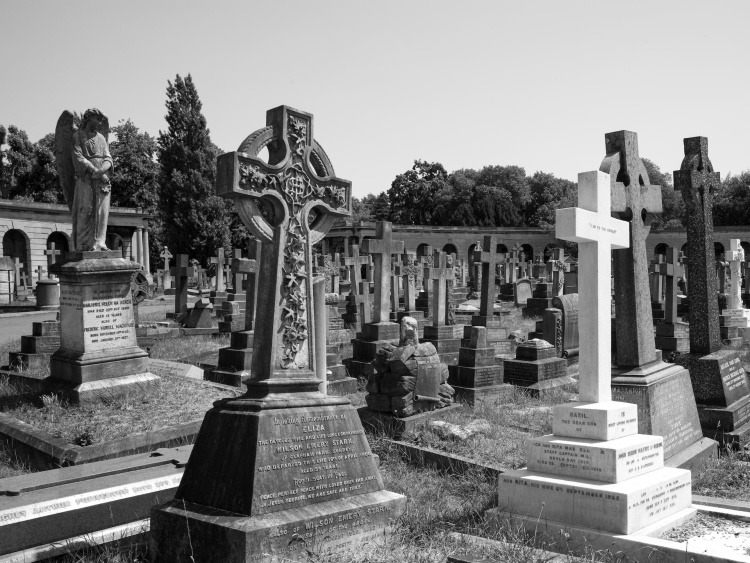
The headstone is a marker that is placed above the grave typically indicating the name and lifespan of the deceased and often including a biblical, poetic or other passage. Most headstones are made of granite, marble, sandstone, slate or other types of stone and range in size from small to grand. Today, in a place like Littleton, we take headstones for granted, but they haven’t always been a part of funerary rights. In this post we’re going to look at the origins of the headstone and how, if at all, it’s changed over time.
Tracking the Origins of Using Headstones for Graves
No one knows for sure who erected the first grave marker. Researchers speculate our now extinct evolutionary cousins the Neanderthals began the practice 40,000 – 50,000 years ago. But markers found on Neanderthal graves bear little resemblance to what we would consider a headstone today.
The gravestone as we know it did not appear until around 5,000 years ago. That’s when ancient people in southeastern Europe and the Middle East first began placing stelae (stone markers) atop the graves of prominent members of the community. When placed on top of a grave stelae usually included a few details about the person buried beneath.
As they did with just about everything else the ancient Romans adopted the idea of the stelae and expanded on it. It became common practice to mark the grave of prominent citizens with stone slabs featuring wordy accounts of the person’s professional or military achievements and sometimes including bits of philosophy or “final words” the deceased wished to share with future generations.
When the Roman Empire morphed into the Catholic Church the tradition of marking graves with slabs of inscribed stone endured and its use was expanded to mark the graves of everyday people. Meanwhile in the Middle East the other Abrahamic religions – Judaism, and to a lesser extent, Islam – also used gravestones to mark the graves of the deceased.
Into the Modern Age
Headstones had become fairly common by the Middle Ages. However, all but the simplest were out of the financial reach of the peasantry. And since most people who owned land buried their loved ones on their property that’s where most tombstones were to be found. As the Middle Ages wore on, church graveyards began to appear and people from all walks of life began burying their dead on these consecrated grounds, feeling it was better for the soul of the deceased.
The size and quality of grave markers in these early cemeteries varied widely. Wealthy local families spared no expense to erect impressive granite monuments topped by elaborate life-size sculptures, while other graves were marked by short, thin sandstone slabs that have cracked and worn flat over time.
During the Victorian era, the rise of the middle class was reflected in the number and quality of grave markers to be found in both church-run and public cemeteries. The average tombstone became larger and was hewn from better quality stone and families began to buy up large plots within the cemetery where all family members would eventually be interred.
The steep increase in human population that began during this period (and continues to this day) also meant there was increasing demand for grave markers and the headstone industry began to expand.
The Emergence of Gravestone Iconography
For centuries if a family could afford a gravestone and the deceased was Christian or Jewish the tombstone would be embellished with either a cross symbolizing Jesus, or the Star of David. Other symbolism, aside from the occasional angel, was discouraged as it was believed it could distract from the primary religious message.
During the 19th century, the gravestone became accessible to more and more people and the quality of the stones began to improve significantly. With these new, more expensive markers came the emergence of various symbolic motifs that Church leaders tolerated. Though in some cases they were not always happy to do so. Even though many of these motifs are still in common use most people are unaware of their meaning. So here is a quick primer on gravestone motifs:
- Square & compass: These indicate the deceased was a member of the Freemasons.
- Ivy: Ivy carving indicates God’s power over death and the promise of life everlasting.
- Alpha & Omega: The first and last letters of the Greek alphabet symbolize the bookends of life.
- Calla lily: The calla lily has been used for thousands of years as a symbol of eternal life.
- The urn: Urns have long been associated with death and are a common cemetery motif.
- The anchor: The anchor stands for God, whose love is a steadying force throughout life.
- Inverted torch: Whereas a lit torch indicates life and hope an inverted torch indicates death.
- DoR: This stands for Daughters of Rebekah, a social order like Freemasons, but for women.
- Elk’s head: This indicates the deceased was a member of the BPO Elks.
For High Quality Headstones in Colorado Contact Mile High Memorials
The headstone has been with us for thousands of years, and though their appearance has changed over time they still play an important role in making sure loved ones are remembered in a respectful and timeless fashion. Mile High Memorials is your premier source for high quality gravestones in Colorado. We’re easy to find, just search for “headstones near me”, or even better, give us a call at 303-794-3443 and ask about our headstone prices and options.

